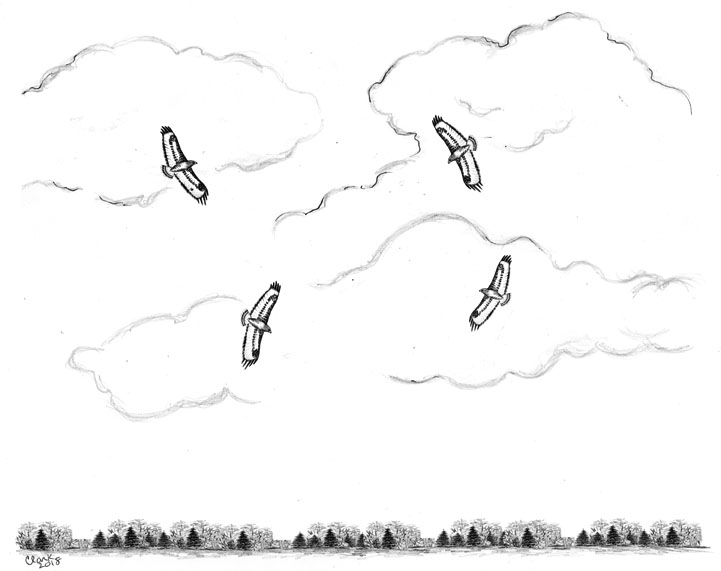
Dear Bird Folks,
Today I saw four hawks hunting together, all circling above a small area in East Orleans. My husband told me I was crazy. He said hawks hunt alone. Do hawks hunt in groups, or am I seeing things?
– Donna, Orleans, MA
No, yes and don’t get me involved, Donna,
With perhaps one exception (Harris’s Hawks of the Southwest), hawks like to dine alone. Therefore, no, hawks don’t hunt in groups. And yes, you were “seeing things.” You just weren’t seeing what you thought you were. While it’s totally possible to see several hawks circling at the same time, they won’t be hunting. (FYI: A group of hawks is called a “cast,” just in case you wanted to know.) As for your husband thinking you are crazy, he knows you better than I do, so I’ll let him make the call on that one.
After I received your note, I decided to stop at the hawk watch in North Truro and run your question past, Don Manchester, the Cape’s resident hawk master. I told him to consider his answer carefully, as your marriage may be riding on it. Don didn’t even hesitate; he just shook his head and said, “Hawks hunt alone.” That was the end of the discussion. Even if I wanted to, I couldn’t go against Don. But if the hawks you saw weren’t hunting, what were they doing? Is there an answer? You bet there is, lots of them. At least, they’re my idea of answers.
One possibility has to do with migration. Most songbirds migrate at night, when there are fewer predators to deal with and the air is generally calmer. Hawk migration is just the opposite. They migrate during the day, partly because they are less concerned with predators (they are the predators) and they are able to use the turbulent air to their advantage. How is that, you ask? As the sun heats things up, the warm air rises. By circling around and around, the big birds catch a ride on the rising air, gradually gaining height until they nearly disappear. Eventually though, the air cools off and the free ride is over. At this point, the hawks stop circling and begin to glide down, but not straight down. Like those crazy people on hang-gliders, the birds will descend slowly, gliding for miles without ever flapping, or using energy. Therefore, Donna, it wasn’t food that brought your hawks together; more likely it was simply warm, rising air. (FYI-2: When hawks gather to ride a thermal, it’s called a “kettle.” Don’t ask me why hawk groups get to have two names. I don’t make the rules.)
Here’s another option: Maybe the hawks you saw weren’t migrating at all; perhaps, instead, they were resident birds. The local Red-tailed Hawks like to soar and circle during courtship or when defending their territories. And speaking of locals, our returning Ospreys have been known to simply go for an “afternoon fly.” When the weather is nice, Ospreys are regularly seen circling high above their breeding grounds. The birds aren’t really going anywhere and the reason for these flights isn’t understood. It could have something to do with territorial displays, or maybe they are cooling themselves off or perhaps the birds simply want to go on their own version of a Sunday drive. (Remember those?) Whatever the reason, it seems to be a fairly common occurrence. I frequently see Ospreys circling above my shop, but in this case, I think the birds are probably eyeballing the business next to us…the fish market.
Here’s one last thought, Donna. Maybe it wasn’t hawks that you saw, after all. No, I’m not questioning your competence (that’s your husband’s job), but instead of hawks, perhaps what you saw were actually vultures…you know, hawk wannabes. Turkey Vultures are becoming more and more common on Cape Cod. And out of all the birds we have just discussed, Turkey Vultures are the most soaringest (?) and only flap their wings when they truly have to. From high above the ground vultures continuously search for prey, which is invariably something dead and rotting. Most other birds find food with their eyes and a few (owls) also incorporate sound to help pinpoint prey. Turkey Vultures take things a step further and actually sniff the air for food. They are equipped with an extra large olfactory bulb, which sounds like something invented by Edison, but actually gives them the ability to smell prey, often long before they can see it. Like flying bloodhounds, Turkey Vultures soar above the countryside in an effort to pick up the scent of some poor creature that didn’t make it through the night. The irony is that vultures have a delicate sense of smell, yet they consume nasty stinky food. Meanwhile, hummingbirds, which feed on lovely fragrant flowers, can’t smell a darn thing. Where’s the justice?
I don’t think you’re crazy, Donna. You clearly saw large soaring birds, but we will never know for sure if they were migrating hawks, or vultures sniffing for food or simply Ospreys flying around for the fun of it. But we do know they weren’t a cast of hawks hunting together. (FYI-3: A group of vultures is known as a “committee”. While I’m not really clear why hawks are called a cast, I have no trouble with this last one. I’ve been to a number of lifeless committee meetings and I totally understand the vulture association.)